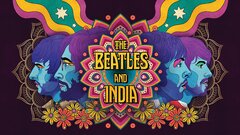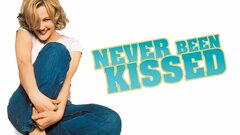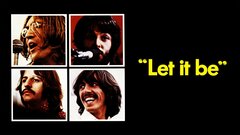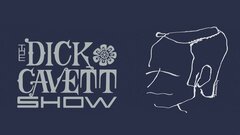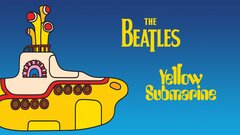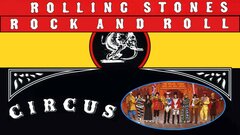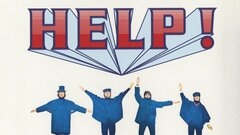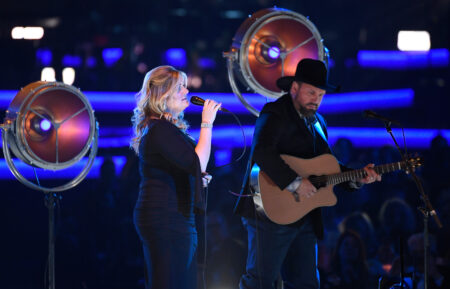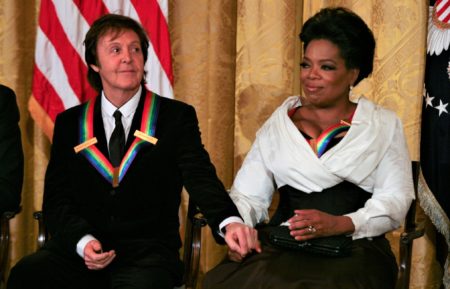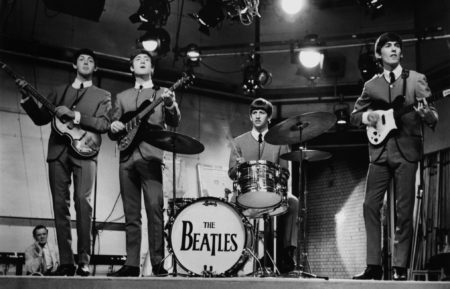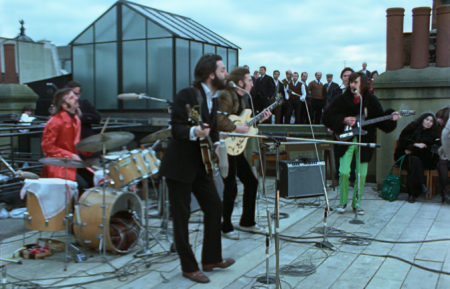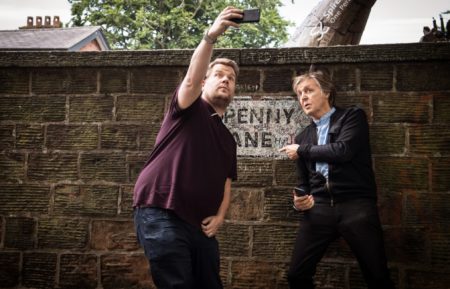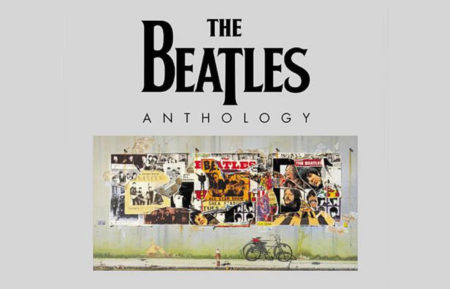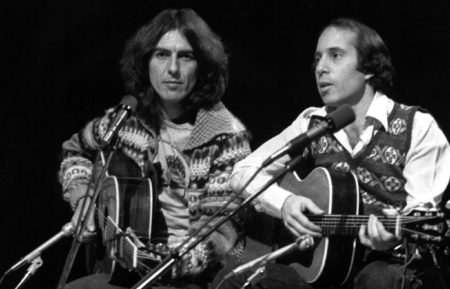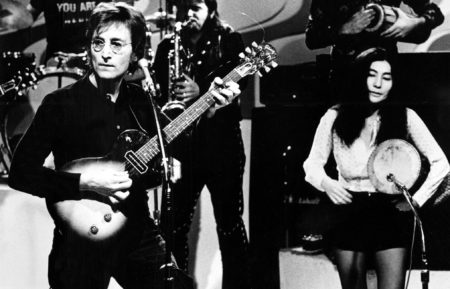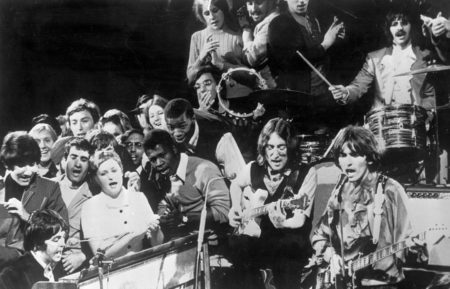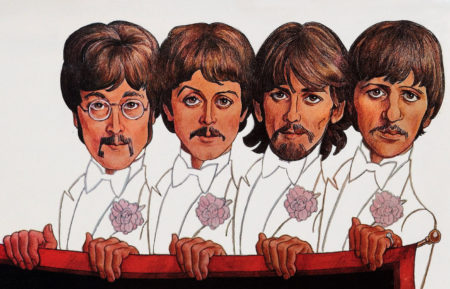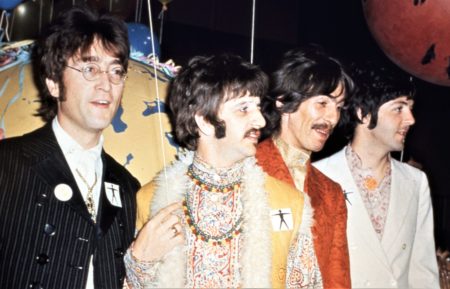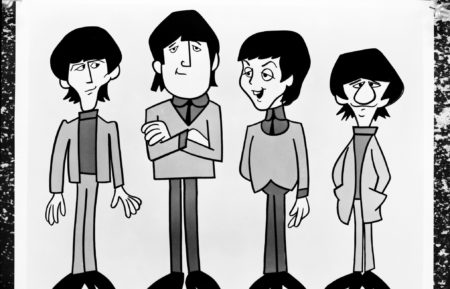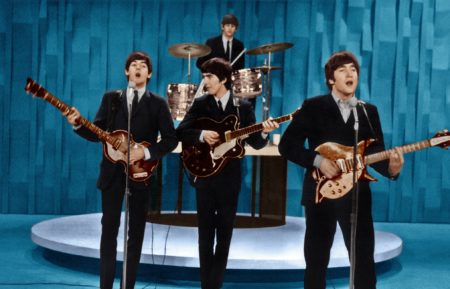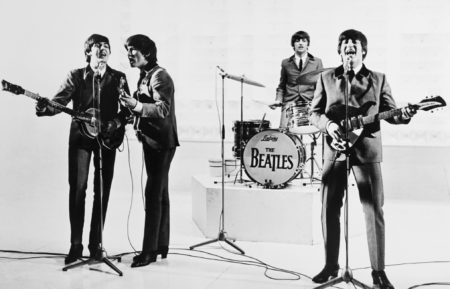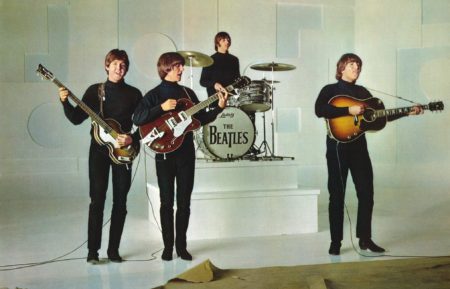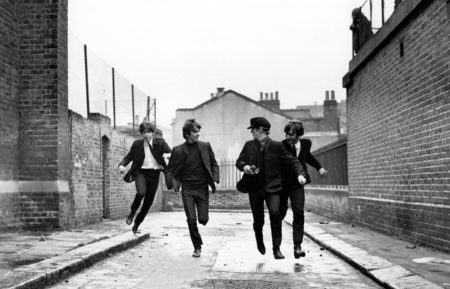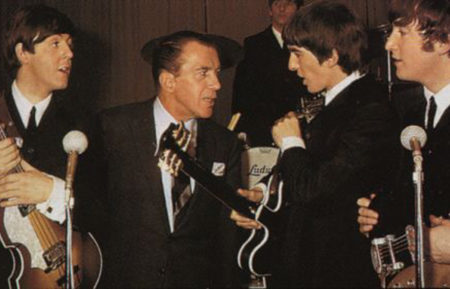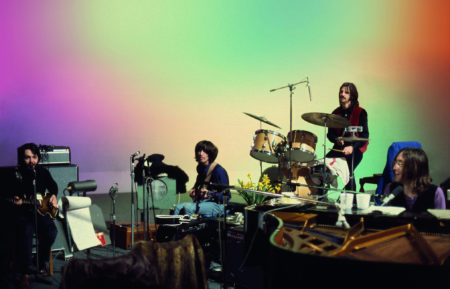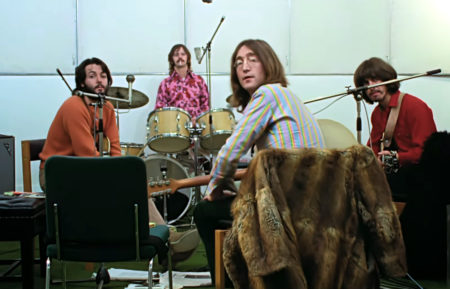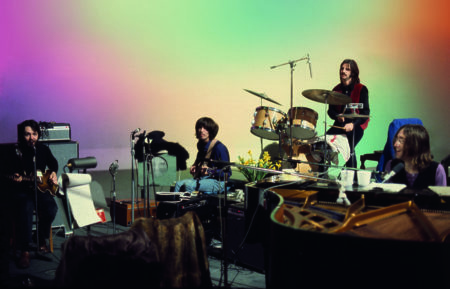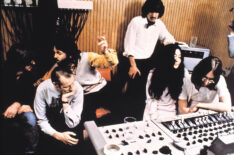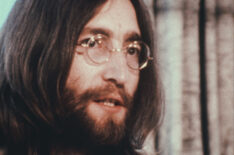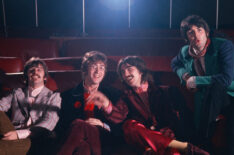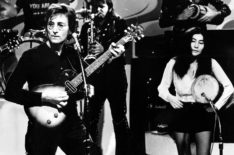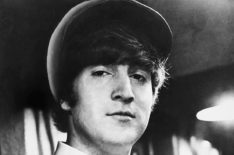A founding member of The Beatles, and, along with Paul McCartney, half of one of the most celebrated and influential writing teams in the history of recorded music, John Lennon was a musician, writer and political activist whose tragic death at the hands of a so-called "fan" deified him in the eyes of the world. Through his music with The Beatles and even his solo literary efforts, Lennon brought wit, fire and poetry to his work.
In the wake of the band's very public and ugly dissolution in 1970, he emerged from the maelstrom that surrounded the group to forge his own musical identity; first as a raw and uncompromising experimental rocker alongside his controversial bride, Yoko Ono, and later as the composer of such wistful material as "Imagine" and "Woman." An assassin's bullet felled him in front of his New York City apartment on Dec. 8, 1980, but his name and image continued to live on as a symbol of peace and hope for future generations.
Born in the middle of a German air raid on Oct. 9, 1940 in Liverpool, England, Lennon's early life reflected the turbulence of his arrival in the world. His mother was Julia Stanley, one of five headstrong daughters born to a well-to-do family in Liverpool. His father, Alf "Freddie" Lennon, was a music hall singer and banjo player whose tenure in the Merchant Navy kept him away from his wife for months at a time; a situation preferred by her family.
Julia became pregnant by another man in 1944, and lived with an abusive common-law husband in 1946, leaving the adolescent John to be raised largely by her sister, Mimi. In 1946, Alf returned from sea and attempted to take Lennon to New Zealand with him, but was thwarted by Mimi and Julia's companion. Lennon had no contact with his father until the height of Beatlemania, whereupon he rejected attempts to reconcile. Julia Stanley herself would die in 1958 after being run down by an off-duty police officer, leaving sister Mimi to raise Lennon with the help of her husband. His mother's tragic death would haunt both his life and music.
Unlike fellow Beatles Paul McCartney, George Harrison, and Ringo Starr, Lennon was closer in standing to middle class; the area in which Mimi lived was populated by professionals and homeowners. Mimi herself attempted to dissuade Lennon from speaking in a Liverpudlian accent, and attempted to bolster his education by buying literature for him. But Julia had bought a guitar for Lennon when he was a boy, and the music of American rock and rollers like Chuck Berry and Elvis Presley proved alluring to the teenager. He began his own skiffle group in 1956, and began playing local events as a member of the Quarrymen, which he had started with some school friends. A mutual friend introduced Lennon to Paul McCartney in 1957, and the pair began performing together that same year.
An instant bond was formed out of both a respect for their mutual musical skills, as well as the fact that both teens had lost their mothers at a young age. A teenaged classmate of McCartney's named George Harrison caught their act in 1958 and joined that year. Mimi found the group - and his band mates - appalling and encouraged Lennon to attend the Liverpool College of Art. It was here where he met and began dating a young woman named Cynthia Powell, who would later become his wife. Despite his artistic talents, his fascination with rock music proved too strong. By 1960, he had dropped out of college, and he, McCartney and Harrison, along with art school friend Stuart Sutcliffe and drummer Pete Best, were playing regular gigs in Germany.
Mimi's opinion of the group changed only after Lennon informed her of how much money he was making as one of The Beatles, the group's new name, Lennon's idea in homage to both Buddy Holly's Crickets and the "beat music" the band played.
Manager Brian Epstein discovered The Beatles at the Cavern Club at Liverpool and shopped them around to various labels to no avail until producer George Martin at Parlophone decided to grant them an audition. After a brief change in band members - Best was asked to leave and replaced by Ringo Starr - The Beatles began recording their first songs with this lineup. Lennon and McCartney had been writing together since the Quarrymen days, but the first official Lennon-McCartney song to be recorded was "Love Me Do," with Lennon providing vocals and harmonica. Initially, all of their compositions were listed as "McCartney-Lennon," but after the first LP, the order was reversed and would remain that way for posterity.
With the release of The Beatles' first album, Please Please Me in 1963, Lennon and the group quickly found themselves at the center of fanatical worldwide attention. Lennon dealt with the focus by relying on his penchant for absurd humor and wordplay; he penned two books of humorous abstract poetry and sketches in 1964 and 1965, and displayed a dazzling wit with the press and in live performance. Occasionally, the latter could get the best of him, as evidenced by his notorious 1966 comment that The Beatles were "bigger than Jesus." The statement unleashed a firestorm of protest across the American Bible Belt and from the Vatican, helping to bring an end to the band's days as a touring outfit.
Lennon's caustic wit also factored into his songs with McCartney; whereas the former could be relentlessly upbeat, Lennon could insert a sarcastic spin or offbeat notion into a track that gave it extra dimension. As writing partners, the two were well-matched; both worked extremely quickly - songs were usually penned within an hour or two - and where McCartney was peerless in regard to melody and arrangement, Lennon's strength lay in his lyrics, which could be playful and surreal ("I Am the Walrus," "Come Together") as well as mature and complex ("Norwegian Wood," "Nowhere Man"). Though the group's decisions were generally democratic, Lennon and McCartney were notoriously tough on Harrison and Starr's compositions; Harrison, in particular, became increasingly frustrated that he could not place more than one or two of his own songs on an album, despite his growing prowess as a songwriter.
In 1962, Cynthia Powell discovered that she was pregnant with Lennon's child; the couple married that same year (much to Mimi's displeasure) and son John Charles Julian Lennon was born in 1963. Initially, the couple enjoyed as quiet and happy a life as one could in the eye of Beatlemania, but by 1964, the pressures of being a Beatle and his growing interest in marijuana (introduced to him by Bob Dylan) and LSD created an unfathomable gulf between the couple. In 1966, Lennon met avant-garde artist Yoko Ono and began a two-year affair that frequently spilled into public view. A horrified Powell filed for divorce in 1968 and despite her pain at the shoddy treatment given her by her ex, admitted she never stopped loving him.
By the mid-1960s, Lennon and The Beatles had changed significantly from their jovial Mop Top personas. The group stopped touring in 1966, focusing exclusively on their songwriting and albums. The period produced some of Lennon's most remarkable work within the group; most notably the psychedelic anthems "Lucy in the Sky with Diamonds" (reportedly inspired by a painting done by Julian) and "Strawberry Fields Forever" (a nostalgic nod to a Salvation Army Children's Home in Liverpool where Lennon heard some of his first live music), as well as "All You Need Is Love," which placed Lennon firmly within the growing peace movement.
But tensions were developing within the group, specifically between Lennon and McCartney, who had assumed the leadership role after the 1967 death of manager Brian Epstein. Lennon had always been the band's acknowledged leader, but his relationship with Ono (and the firestorm of negative criticism hurled at her by the press), drug use (which now included a brief dalliance with heroin), and growing interest in the anti-war movement had shifted his primary focus away from the band. Still, he resented McCartney's suggestions, such as a return to live performance, and projects like the "Magical Mystery Tour" (1967) album and television special and "Let It Be" (1970) documentary. By 1968, Lennon would only appear at a Beatles recording session with Ono in tow, which drove a further wedge between the members, who resented her constant presence and became, in fact, jealous of the attention he lavished on her instead of them.
As The Beatles began to slowly implode over the next two years, Lennon made significant strides to establish his own identity outside of the group. He had stepped away from them in 1966 to co-star in "How I Won the War," a satirical and surreal anti-war film for Richard Lester - who had previously directed Lennon in The Beatles features "A Hard Day's Night" (1964) and "Help!" (1965) - but by 1968, he was appearing more and more without his band mates. His first performance outside of The Beatles since his pre-Quarrymen days came in "The Rolling Stones Rock and Roll Circus" (1968) as part of The Dirty Mac, a supergroup featuring Keith Richards, Eric Clapton, Mitch Mitchell of the Jimi Hendrix Experience. He and Ono also released a trio of experimental albums through The Beatles' Apple Records: 1968's Unfinished Music No. 1: Two Virgins, which gained worldwide attention for its cover photo of a full frontal nude Lennon and Ono; Unfinished Music No. 2: Life with the Lions; and Wedding Album.
All three were deeply avant-garde affairs, filled with Lennon's guitar feedback and Ono's keening vocalizations, and did little to cheer Beatles fans already troubled by reports of the group's tensions. 1969 also saw the release of Live Peace in Toronto, a live album with Clapton, longtime Beatles associate Klaus Voorman, Ono, and Yes drummer Alan White, finding Lennon tearing through several classic rock songs from the '50s with renewed vigor, as well as two lengthy experimental tracks by Ono.
In 1969, Lennon and Ono married in Gibraltar, and decided to use their honeymoon in Amsterdam as a publicity event to promote world peace. Their "Bed-In," which took place over the course of a week at the Amsterdam Hilton, found the couple in bed and happily discussing peace with inquisitive reporters. They later flew to Vienna to promote their tongue-in-cheek protest against racism, which they called "Bagism" and required the participant to cover their entire body with a large bag. A second Bed-In was held in mid-1969 in Montreal, where he and several celebrities - including Allen Ginsberg and Timothy Leary - recorded his anthem "Give Peace a Chance." The song was immediately picked up by the peace movement, and was performed by no less than a half a million demonstrators in Washington DC at the second Vietnam Moratorium Day in late 1969. Though the press frequently attempted to pass off Lennon and Ono's theatrical protests as eccentric, no other major rock performer of the period devoted as much time and energy to promoting the cause of world peace as Lennon.
That same year, Lennon declared that he was quitting The Beatles, as relations between the four members were so divisive during the recording of their final albums, Abbey Road (1969) and Let It Be (1970), that the band members were rarely performing in the same studio, much less speaking to one another. Lennon agreed to keep the news of his departure a secret until negotiations for the group's final recording contract were completed. However, McCartney revealed that he was leaving the group in early 1970, timing it to coincide with the release of his own solo debut, which infuriated Lennon and the other two Beatles. He publicly chastised McCartney in interviews for several years after the group's breakup; even putting his feelings about his former writing partner onto vinyl with the devastating "How Do You Sleep?" from his 1971 solo album Imagine. In Lennon's mind, he had loved McCartney like the brother he never had and his trumping announcement was a final betrayal. The duo would not mend fences for several years.
Lennon worked hard to shed his Beatles skin in the 1970s, but his musical efforts often struggled to reach the same audiences as his work with the group. His 1970 single "Instant Karma" was well-received, but "Cold Turkey" (about his experiences withdrawing from heroin) was not. His first post-Beatles solo album was 1970's John Lennon/Plastic Ono Band, on which he unleashed years of pent-up frustration and anger at societal injustices - particularly at the hands of organized religion - and his own childhood traumas; much of the album's harrowing sound was due to Lennon and Ono's exploration of primal therapy. The album broke the Top 10 in America and the U.K., but failed to beat McCartney's more mainstream solo efforts. One of the album's best songs, "Working Class Hero," was even banned in several markets for the use of an expletive. Its follow-up LP, 1971's Imagine, fared much better with listeners. The primal therapy touches and attacks on religion from Plastic Ono Band were still present, but balancing them out were the gorgeous title track, which became one of Lennon's most enduring compositions, as well as the deeply personal "Jealous Guy" (which began life as a Beatles track titled "Child of Nature") and the politically charged track "Gimme Some Truth." The album rose to the top position on record charts and became a perennial seller for fans discovering Lennon's first truly accessible solo work for the first time.
Lennon and Ono relocated from England to New York City that year, and trouble beset the couple almost immediately. He began making the acquaintance of several noted members of the American peace movement, including Jerry Rubin and Abbie Hoffman, and planned a 1972 national tour to coincide with the upcoming election that would encourage 18 year olds - who had received the right to vote that year - to register and vote against the Republican incumbent, Richard Nixon. The Nixon Administration launched a campaign to deport Lennon from the country on the basis of a 1968 marijuana conviction, forcing him to spend the next several years fighting to stay in America. The tour never came to fruition, but Lennon and Ono actively spoke out against the war in Vietnam and Nixon, including their infamous week-long stint on "The Mike Douglas Show" (syndicated, 1961-1982), which saw them inviting Hoffman and Rubin to appear as guests. The immigration battle and Nixon's re-election in 1972 took its toll on Lennon, as did the failure of his third solo album, the politically-charged Some Time in New York City (1972). McCartney had also gone to court to dissolve The Beatles' partnership during this period as well, which meant that all four ex-members were unable to earn money from their solo careers until the case was settled (which was not until 1976). Lennon performed two charity concerts at Madison Square Garden that year, which would be his final full-length appearances.
Behind the scenes, he was struggling with alcohol, and his marriage to Ono was crumbling. At her behest, they separated, and he relocated to Los Angeles for 18 months with his assistant, May Pang, whom Ono had put in charge to assist him in both business and extra-marital duties; a mistress of sorts whom she could control from afar. The period, dubbed Lennon's "Lost Weekend," saw him produce the album Pussy Cats (1974) for notorious hellraiser Harry Nilsson and indulge in drunken and cocaine-fueled excesses with Starr and Who drummer Keith Moon. Lennon was widely photographed with Pang, and earned headlines around the world for being forcibly thrown out of the Troubadour nightclub in West Hollywood after heckling the Smothers Brothers act after downing one too many Brandy Alexanders at Nilsson's behest. He also managed to reunite briefly with McCartney for a chaotic, drug-fueled jam session that was recorded on the bootleg album A Toot and a Snore (1974). Lennon and Pang returned to New York in 1974, which was followed by a period of extensive writing and recording. An attempted album of oldies covers with Phil Spector fell apart, with Lennon later re-recording the tracks for his 1975 solo LP Rock 'n Roll.
But 1973 saw the release of the gold album Mind Games, followed by collaborations with Elton John, David Bowie (Lennon co-wrote his No. 1 single "Fame") and Mick Jagger. In 1974, he and Pang returned to New York, and Lennon performed his final live appearance in front of a major audience at a concert by Elton John at Madison Square Garden. Lennon signed the papers that dissolved The Beatles' partnership in 1975, and for the first time in almost half a decade, he and McCartney began regarding each other with something approaching warmth.
In 1975, Pang and Lennon ended their unusual relationship, and he reconciled with Ono. On October 9th of that year - Lennon's 35th birthday - Ono gave birth to their son, Sean Ono Lennon, later a respected musician in his own right. The event was little short of a miracle, as Ono had miscarried three previous times. Lennon turned his back on the music industry and devoted his full energies to raising his son and attempting to rekindle his long dormant relationship with Julian, whom he had seen sporadically during the 1970s (and who would develop a music career of his own in the mid-1980s). For the next five years, Lennon stayed largely out of the spotlight; he was the best man at actor Peter Boyle's wedding in 1977, and received McCartney at his home in the Dakota apartment in New York on several occasions, most notably on the evening in 1976 that Lorne Michaels made an appeal for all four Beatles to reunite on "Saturday Night Live" (NBC, 1975- ). Both men considered it for a laugh, but were too tired to carry it through. He also fulfilled a lifelong dream of learning to sail, and traveled to Bermuda with a small crew in 1980. The angry young man of the 1960s and 1970s was settling into a content state as he approached his 40th year, happy to be nothing more than, as he called it, "a bread-baking house husband" and doting father, while "Mother" (his pet name for Ono) ran the lucrative Lennon business in the office downstairs in their high-end Manhattan apartment building, the Dakota.
The trip to Bermuda proved fruitful for Lennon beyond his sailing aspirations. He had been writing and recording the occasional song in New York, but after arriving in the Caribbean, he was seized by the creative spark and began writing new material and reworking existing songs. Ono herself was working on new material - her singing career had survived the brickbats of her earliest critics and was finding new appreciation in punk and avant-garde circles - so by August of 1980, the pair had enough material to fill not one, but two albums. The first release would be Double Fantasy, which marked the first time Lennon and Ono had recorded an album together since Some Time in New York City. Unlike the harsh and overly political tone of that album, Double Fantasy had a gentler vibe, befitting Lennon's newfound homemaking happiness. Songs like "(Just Like) Starting Over," a tribute to the mending of his relationship to Ono; "Watching the Wheels," about his days as a house husband; and his achingly beautiful tribute to Sean, "Beautiful Boy (Darling Boy)," were met with overwhelmingly positive response by listeners, who sent the songs to the top of the charts and the album itself to the Top 20 in the U.S. A jubilant and recharged Lennon and Ono began rehearsals for a projected follow-up, titled Milk and Honey.
But their newfound happiness with both family and career was about to come to an unbearable end that no one could have predicted. On Dec. 8, 1980, Lennon and Ono were returning from the studio to the Dakota around 10:50 p.m. As they approached their apartment complex, a deranged young man who claimed to be a fan, Mark David Chapman, who had waited outside the Dakota earlier that same day to have Lennon sign his copy of Double Fantasy, approached the couple and shot Lennon four times in the back, then calmly stepped outside to await his arrest, clutching his copy of J.D. Salinger's Catcher in the Rye to his chest. The former Beatle was rushed by police on the scene to the Roosevelt Hospital, where he died of massive blood loss just 20 minutes later. Howard Cosell broke the news to America within minutes during an NFL football game. A massive vigil formed outside the Dakota that night and for days after, with tributes to the fallen artist soon spreading across the globe. A grief-stricken Ono asked for 10 minutes of silence on Dec. 14, 1980, and millions complied. Thousands gathered in Liverpool and Central Park in New York to pay their respects, many crying, holding candles and chanting "Give Peace a Chance." Ono would later oversee the construction of Strawberry Fields, a memorial garden situated across from the Dakota, which opened on Lennon's birthday in 1985.
Lennon's senseless death was memorialized by countless artists and musicians, including Paul Simon, Queen, and Elton John - Sean Lennon's godfather, who penned his own tribute to his friend, "Empty Garden (Hey, Hey Johnny)" in 1982 - as well as the three remaining Beatles who, more than anyone, were shell-shocked. Putting any remaining personal rancor aside, McCartney and Starr reunited with Harrison for the song "All Those Years Ago" from his Somewhere in England LP, and McCartney penned the incredibly touching "Here Today" for his Tug of War album in 1982. Lennon's own final recordings shot up the charts in the wake of his passing, and Ono worked tirelessly to make sure that his recordings - both previously issued and unreleased - and legacy were preserved for his ever-growing legion of fans. Two of those unreleased songs, "Free As a Bird" and "Real Love," were reworked by the surviving Beatles for the massive "Beatles Anthology" project, and released as singles in 1995 and 1996.
In the decades since his death, Lennon was essentially canonized by the press and fans for his independent streak, immense songwriting talents, and tireless campaigning for peace. In 1991, he received an honorary Lifetime Achievement Award from the Grammy Awards, and was inducted into the Rock and Roll Hall of Fame as a solo performer in 1994 (The Beatles had been inducted as a group in 1988). Parks, airports, and even a minor planet in 1983 were named in his honor. In 2002, the BBC listed him eighth in a list of the 100 Greatest Britons. And in 2007, Ono dedicated a memorial to her husband in Iceland, the Imagine Peace Tower, which generated a beam of light into the sky each year between October 9 and December 8.
Lennon's music found new admirers every year thanks to compilations and reissues supervised by Ono. A feature film on Lennon's life called simply "Imagine: John Lennon" was released to wide acclaim in 1988. She and the other surviving Beatles also collaborated with the French acrobatic troupe Cirque du Soleil on their show "Love," which was built entirely around Beatles songs reworked and re-imagined by their original producer, George Martin. The production debuted at the Mirage Hotel in Las Vegas in 2006 and Ono accompanied McCartney, Starr, and Olivia Harrison to the show's one-year anniversary in 2007. That same year, teenaged girls around the world fell in love with Lennon's music with The Beatles when it was featured in Julie Taymor's romantic fantasy film "Across the Universe." It was apparent that Lennon's persona - that of an angry young man; a fragile man; a man with faults he shared with the world like no other - would never be forgotten, as each year, even decades later, fans of all ages continued to honor him with candlelit services outside the Dakota on both his birthdate and the day his life was ended.








